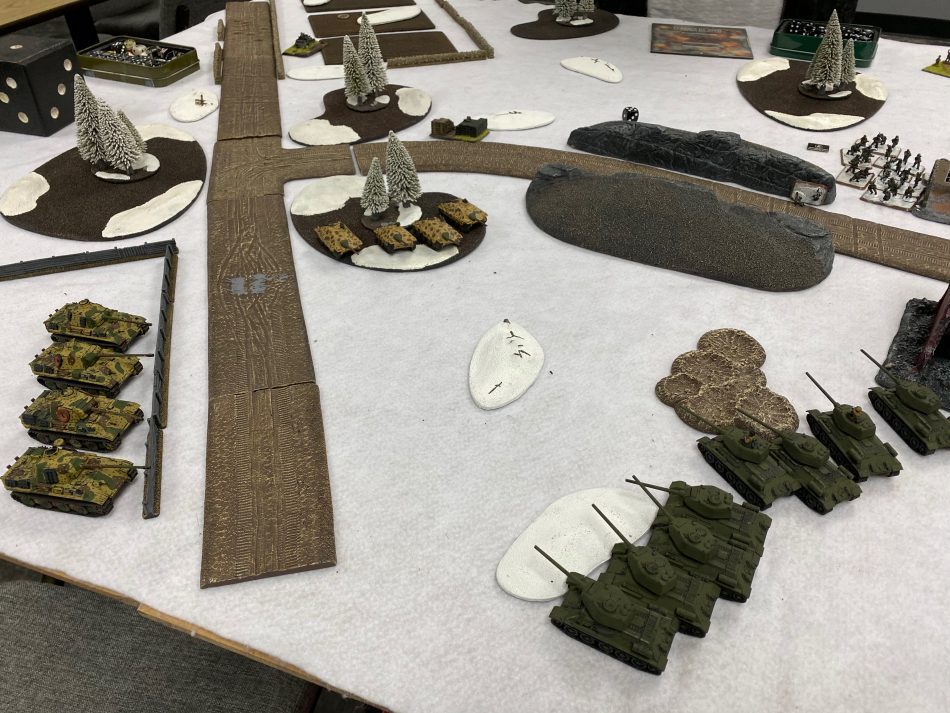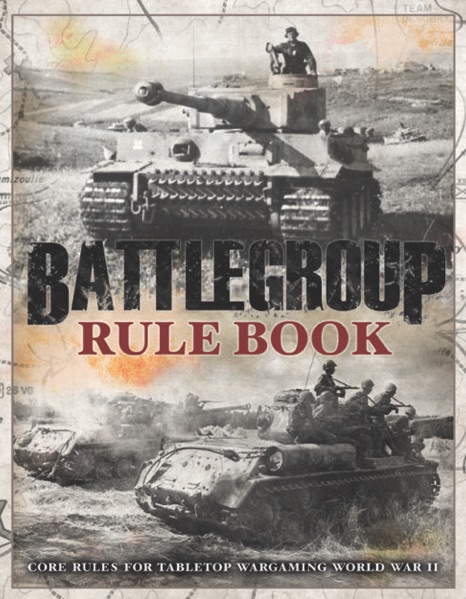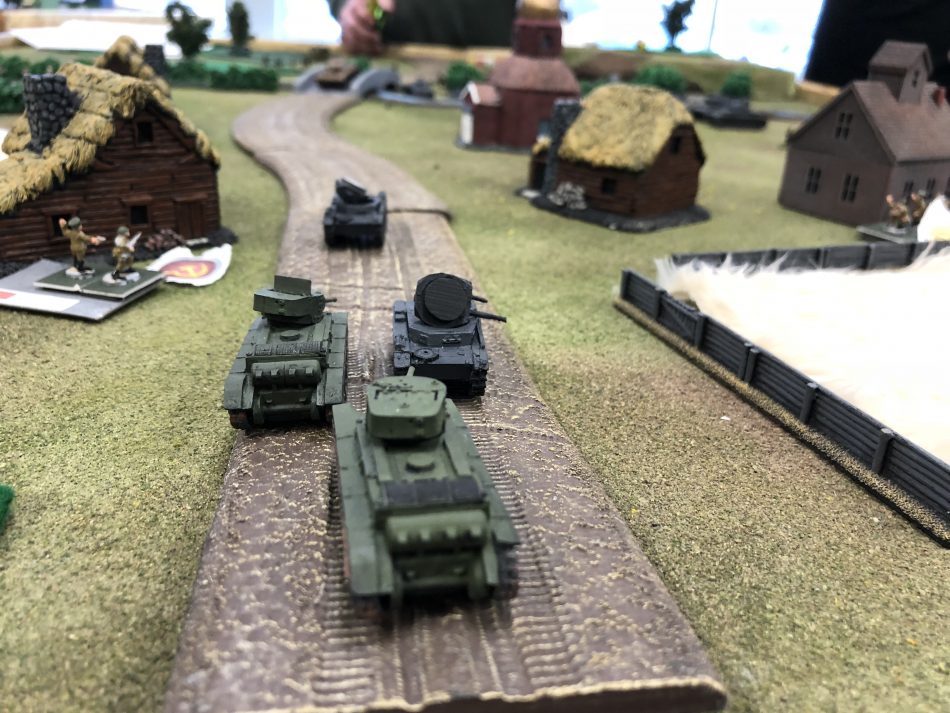A Survey of WWII Rulesets Part 1
By Tom Gall
There are a good number of quality WWII rulesets in existence, let’s explore some of these rules, point out what their strong/weak points are and compare what might draw you to one over the other.
The rulesets considered in this article are : by Battlefront, by Too Fat Lardies, by Warlord, by Plastic Soldier Company.
Each of these rules is generally company level actions with support, for the most part, feature individual models, and focus on the WWII era. All are D6 based. All have extra material that offer campaign experiences, lists, and flavor to feel like you’re been given command with a battle to win. All are either point costed and/or have a list building system which makes it easier to put together a game.
This week, we’ll look at two of the four: FOW and Battlegroup. The other two systems will follow in a later article.
– Battlefront
Flames of War leads off the list. It is a U-go-I-go system, where during the turn the first player moves, fires, assault, etc where everything in their force is able to activate. Then the second player does the same. With the exception of anti-aircraft fire, there is no concept of interrupting/opportunity fire.
Range bands are just short and long, divided at 16″. The experience level of a unit determines how easy something is to hit. Those range from a Cautious 4+, to Reckless 2+ on a D6. There are few modifiers when shooting, concealment for +1, gone to ground, smoke, almost make the entire list.
If a hit is scored, the target of the attack gets a save of 3+ for infantry. For armor is a d6 plus the armor rating of the vehicle. Should a save fail, the infantry or soft-skinned target is either destroyed. If the target is in bulletproof cover (for infantry) or is an armored vehicle, the shooter then must roll a firepower test which determines if the unit is destroyed.
The object of the game is to take objective(s). Depending on the scenario, and if you are attacking, your ability to defend or take an objective by starting the turn within 4″ and then drive the defender more than 4″ away from that objective by the end of your turn will win or lose you the game. Breaking the morale of their army is also possible but generally more difficult.
Flames of War has a fairly rich set of army lists to choose from. When you build a force, you’re assembling a company plus support. They are loosely historically based. The force builder can be found at , it does cost extra.
 Flames of War splits the war into three time periods. Midwar and Late War are being “rebooted” into version 4 of the rules. As such if you want to play Early War, you have to purchase version 3 lists. For Late War the entire period is not covered as of yet so if you want to play with a King Tiger, you’ll be left waiting until that material is re-released. Battlefront is fairly good about making their long-range intentions known for upcoming releases.
Flames of War splits the war into three time periods. Midwar and Late War are being “rebooted” into version 4 of the rules. As such if you want to play Early War, you have to purchase version 3 lists. For Late War the entire period is not covered as of yet so if you want to play with a King Tiger, you’ll be left waiting until that material is re-released. Battlefront is fairly good about making their long-range intentions known for upcoming releases.
FOW has a vibrant tournament scene. If you enjoy attending tournaments matching your lists against someone else for a Saturday afternoon of usually three rounds of games, FOW is something is look into. In the US and Canada, there is a national ranking system and a masters event at the end of the year.
If you’re looking for a more historical simulation, this is where FOW falls short as there isn’t a set time per turn, and there isn’t a set scale, meaning 1″ does not equal a certain distance. While this might seems like odd design quality, it works. For a 4×6 table (which is the standard sized table you play on), at scale artillery would never be on the table, thus a range system with an unset scale makes this work.
Most players utilize 15mm scale for models, and this scale is required for tournament play. Last Flames of War is built for a 1×1 type play experience. While one can scale up for larger match ups, the majority of the material isn’t built for it.
 – Plastic Soldier Company
– Plastic Soldier Company
Battlegroup (BG) is a platoon to battalion-sized game. Since BG is architected to allow for small platoon sizes games up to battalion-sized games, it gives the gamer freedom to choose the right size game table.
Battlegroup is a U-go-I-go system. However, at the beginning of your turn, you determine how many orders you are able to issue by a die/dice roll. Units need orders to move, fire, etc. More command gives you more orders.
The number of orders you have can be less than the number of units you have, you need to think tactically. Units may be placed on ambush orders which allows a player to interrupt the other for opportunity fire or an opportunity move.
Battlegroup has a rich well-developed concept of range bands that fall off with distance. As scale has meaning on the BG tabletop, artillery is largely off the table. Spotting, shooting, and saves are all used d6 based, however for armored vehicles, 2d6 are used to determine penetration. This builds more variability and flavor into the wide variety of weapons and armor in use during the war.

For force morale, the game uses a system of chits that you draw when certain events occur – such as the loss of a unit. The chits either give you access to special events (a rare occurrence) or count against your battle rating. When your battle rating drops to zero, the backbone of your force is broken, and they withdraw. The chits are drawn and their total value is held in secret, so your opponent never really knows how close you are from breaking. The system works really well and adds significant drama to the game experience.
Battlegroup has a rich set of army lists, broken down by theatre and time period. The books offer matching lists that are point costed to easily put together a fun matchup. There are special rules that offer flavor unique to forces as well as modeling doctrine in use or other limitations or capabilities.
When you build a force, depending on the points chosen, you’ll put together a platoon all the way up to a battalion-sized force with support options. There is a community constructed force builder and it is free to use.
Battlegroup does not have a set model size scale. There are players utilizing 10mm, 15mm and 20mm. Smaller models, allow for larger battlefields in the same size space. Larger scales, look great. The downside to an unset scale is when you meet up with other players hopefully you’ve both invested in the same scale.
Battlegroup does not have a tournament scene. It fits in with a scenario-driven style of play over the course of an afternoon or evening. BG also works well with more than one player on a side.
Next week, Part 2 of the survey, as well as my closing thoughts.


Have you ever played Spearhead by Arty Conliffe? My personal favorite WWII set of rules. It’s older now and not much played at conventions. Not tournament rules but a great, easy to learn game.
Or Crossfire by him , also PBI by Perterpig , both are more infantry based games .
Nice summary/run down – thanks for sharing. I would add that BG encourages the player to build balanced forces using the army lists, or to have forces based on the actual historical events. As it is very much scenario driven, you have a lot of flexibility with the two approaches, and perhaps favours a more ‘historical’ game.
I have not played FOW, so all I can say about it is that the ‘tank park’ games (like the one in the photo towards the top of your post) leave me cold!
I would also suggest another TooFatLardies game – I Ain’t Been Shot Mum. It is also focused on company level games and, like all TFL games, has the concepts of C&C and friction at hte heart of the system.
Another local favorite is Command Decision III tho not played as much these days. Blitzkrieg Command, Battleground, to name a few that are on the shelf. Always interested in the recommendations of others.
Prefer platoons as the atomic unit for WWII as it prompts combined arms. Innovative Command Decision led the way but of course I prefer Combat Command.